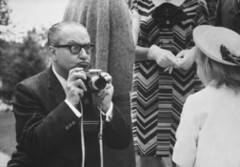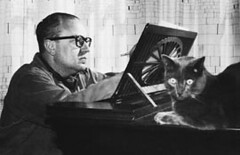In 1939 he premiered his first ballet titled Panambíi. A year later the director of the American Ballet Caravan, Lincoln Kirstein commissioned a second choreographic work called Estancia. The troupe disbanded in 1942; however Ginastera extracted an orchestral suite from its score. It premiered in 1943 and was received warmly. This and other works contributed to his growing popularity as one of the most t musically moving composers associated with the nationalist movement.
In 1941 he began teaching at the National Conservatory and the San Martín National Military Academy. He also married that year. He remained stable in Argentina until 1945. He signed a petition in support of civil liberties the Peronist regime forced his resignation from the National Military Academy. He previously received a Guggenheim grant which he postponed and used it to travel to the USA with his family. He stayed from 1945 until 1947. While in the U.S he visited Juilliard, Harvard, Yale, Columbia and Eastman music schools.
In 1948 he played an influential role in founding the Argentine section of the International Society of Contemporary Music (ISCM). , He also organized and became director of the conservatory of music and theatre arts at the National University of La Plata. Unfortunately he faced difficulties with the Perón government and in 1952 he was forced to resign his directorship at La Plata. He didn’t regain his post until 1956. This was the year after Perón's defeat. Despite difficulties during those years, his creative production thrived, and he produced three splendid works, the Piano Sonata no.1 (1952), Variaciones concertantes (1953) and Pampeana no.3 (1954). These earned him great recognition.
He became a full professor at La Plata in 1958, but resigned later that year. He was asked to organize and direct the faculty at the Catholic University of Argentina. There he served as dean until 1963. In 1958 he composed the String Quartet no.2. He combined a brilliant comination styles and techniques he used earlier with early incursions into serialism. At its première by the Juilliard String Quartet it was hailed as the zenith of the First Inter-American Music Festival. From this moment on his international reputation was guarenteed. . Brilliant first performances of his Piano Concerto no.1 and Cantata para América mágica at the Second Inter-American Music Festival fused his artistic status. He now composed almost exclusively by commission.
In 1969 he seperated from his wife which began a troubled period in his professional life. He was unable to focus on this work he was overwhealmed and distracted. Fortunately he met Argentine cellist Aurora Nátola which helped respark his creativity. In 1971 they married.
During his last 12 years he composed phenomenal works. One work in particular is called Turbae ad passionem gregorianam (1974). He was awarded the grand prize of the Argentine National Endowment for the Arts in 1971 and the UNESCO International Music Council music prize in 1981. He died in 1983 in Switzerland.
His music was in a nationalistic idiom up to about 1958 when he adopted more advanced procedures including serialism microtones, and aleatory rhythms.
Link to discography


Sources:
"Ginastera, Alberto." The Oxford Dictionary of Music, 2nd ed. rev. Ed. Michael Kennedy. Oxford Music Online. 8 Mar. 2012< http://www.oxfordmusiconline.com/subscriber/article/opr/t237/e4275>.
Deborah Schwartz-Kates. "Ginastera, Alberto." Grove Music Online. Oxford Music Online. 8 Mar. 2012 <http://www.oxfordmusiconline.com/subscriber/article/grove/music/11159>.
No comments:
Post a Comment